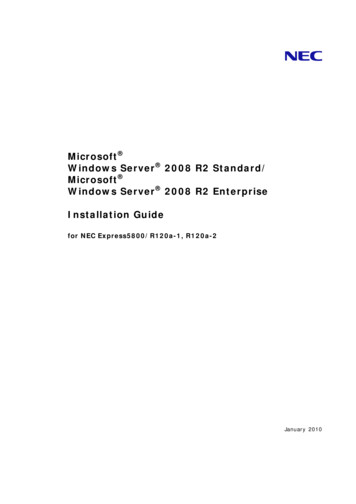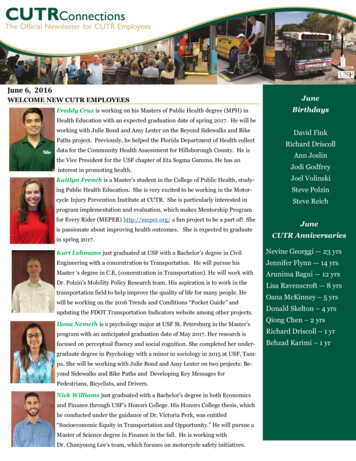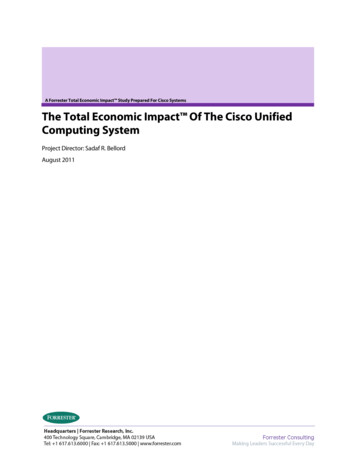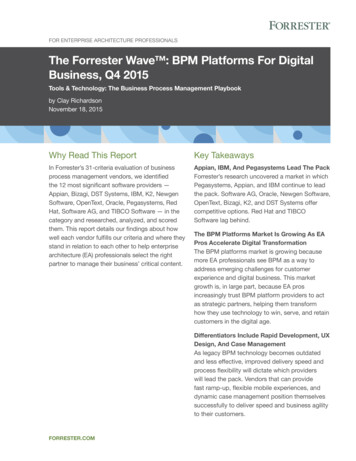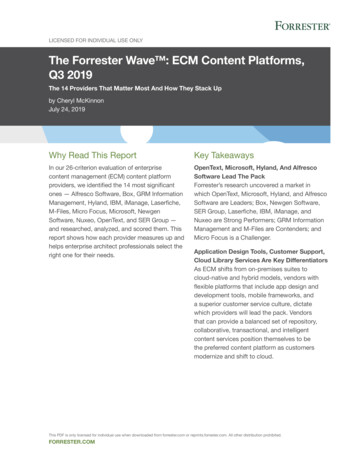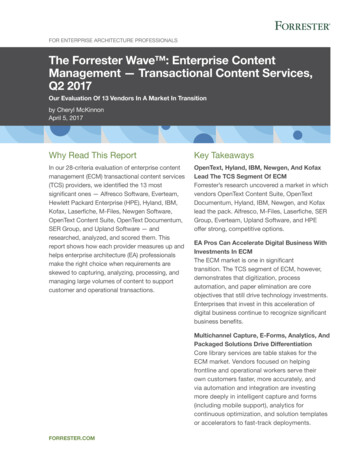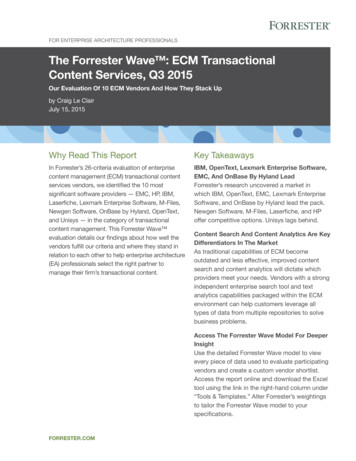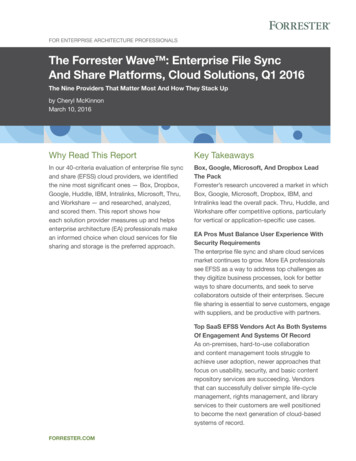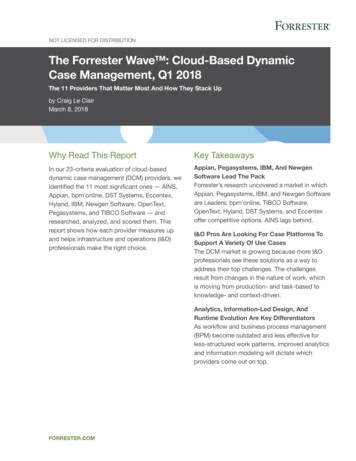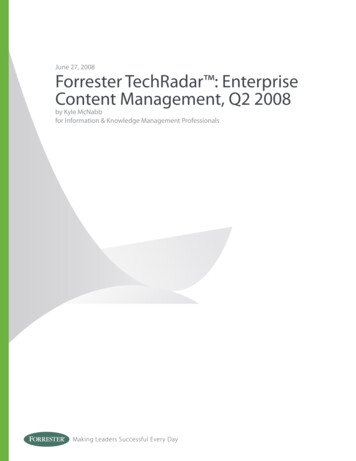
Transcription
June 27, 2008Forrester TechRadar : EnterpriseContent Management, Q2 2008by Kyle McNabbfor Information & Knowledge Management ProfessionalsMaking Leaders Successful Every Day
For Information & Knowledge Management ProfessionalsIncludes a Forrester TechRadar June 27, 2008Forrester TechRadar : Enterprise ContentManagement, Q2 2008Content Services Are Disruptive; Imaging Delivers High Business Valueby Kyle McNabbwith Connie Moore, Craig Le Clair, Stephen Powers, Rob Koplowitz, and Shelby CatinoEXECUT I V E S U M MA RYThe volume of emails, video, documents, Web sites, collaborative workspaces, scanned images, corporaterecords, blogs, statements, and other types of content continues to explode. Enterprises don’t just needto manage content to reduce risk, they must manage it to improve business processes, transform stalecustomer experiences, and enrich employee collaboration. Yet many information and knowledgemanagement (I&KM) professionals believe they’ll have an easier time herding cats than finding theright mix of enterprise content management (ECM) technologies to manage this explosion — it’s tough.To simplify planning, Forrester analyzed ECM technologies by evaluating maturity and business value.Content services and enterprise rights management stand ready to displace legacy ECM investments,while the granddaddy of ECM — imaging — continues to deliver strong business value.TABLE O F CO N T E N TS2 The State Of Technology Planning For ECM2 Why The Future Of ECM Matters3 Overview: Forrester’s TechRadar For ECM9 TechRadar: Imaging Delivers Business Value,While Content Services DisruptRECOMMENDATIONS22 Make ECM A Portfolio Strategy, Not Simply ASuite Strategy23 Supplemental MaterialN OT E S & R E S O U R C E SFor this TechRadar , Forrester examined pastresearch on ECM, interviewed 20 expertsresponsible for building or implementing thesetechnologies, and spoke with more than 30enterprises using varying ECM technologies.Related Research Documents“Enterprise Content Management’s Next StepForward”February 29, 2008“Business Context: A Better Way To Define AnECM Strategy”December 27, 2007“The Forrester Wave : Enterprise ContentManagement Suites, Q4 2007”November 9, 2007 2008, Forrester Research, Inc. All rights reserved. Forrester, Forrester Wave, RoleView, Technographics, TechRadar, and Total Economic Impactare trademarks of Forrester Research, Inc. All other trademarks are the property of their respective companies. Forrester clients may make oneattributed copy or slide of each figure contained herein. Additional reproduction is strictly prohibited. For additional reproduction rights andusage information, go to www.forrester.com. Information is based on best available resources. Opinions reflect judgment at the time and aresubject to change. To purchase reprints of this document, please email resourcecenter@forrester.com.
2Forrester TechRadar : Enterprise Content Management, Q2 2008For Information & Knowledge Management ProfessionalsTHE STATE OF TECHNOLOGY PLANNING FOR ECMUnstructured data — such as email, documents, scanned images, faxes, Web copy, audio and video,blogs and wikis — makes up the majority of information that fuels operations within any enterprise.This unmanaged content leads to chaos, compelling I&KM pros to turn to ECM technologies tocapture, manage, retain, and put content to use in business processes, Web sites, and delivery channels.Yet ECM means different things to different people. For some, it may mean content repositoryconsolidation, while for others it may mean proliferation of Microsoft Office SharePoint Server andIBM Lotus Quickr. Legal teams may view ECM as an answer to eDiscovery, whereas IT teams may(mistakenly) see message archiving as a long-term fix for records management. And marketing teamsoften view ECM as a way to target rich content to customers across multiple channels.ECM technologies have crystallized as the focal point for many I&KM pros looking to addresscompliance, governance, process efficiency, worker productivity, and customer experience needs.But finding a single technology that completely meets the enterprise’s need to manage and usecontent remains impossible.WHY THE FUTURE OF ECM MATTERSI&KM pros can make substantial impact in their enterprises if they choose the right projects andtechnologies that:· Protect the enterprise from risk, while embracing the ways business people work. Managingcontent helps keep the enterprise out of trouble by enforcing policies to keep or get rid ofcontent. But the technology supporting these policies cannot simply archive, lock down, ordestroy content — it needs to support the varying and evolving ways businesspeople work.1· Drive content into business processes to improve efficiency or business optimization.Managing content helps the enterprise improve transactional business processes, like invoicingor new-account opening.2 Supporting these transactional business processes requires ECMtechnologies to infuse content into the business process, making it available to the task workerwhen he needs it to quickly move on to the next transaction.· Make content easily accessible and shareable within employee collaboration efforts.Managing content enhances business collaboration efforts, like contract management, capitalproject collaboration, and call center FAQ wikis. But businesspeople often shun solutionsthat thrust the complexity of content management upon them. ECM’s support for employeecollaboration will be based on how content is accessed and shared, while hiding the complexityof content management — such as taxonomy and metadata — from businesspeople.· Deliver content in more targeted and dynamic ways to improve the customer experience.Managing content also helps the enterprise deliver better, more persuasive customer experiencesJune 27, 2008 2008, Forrester Research, Inc. Reproduction Prohibited
Forrester TechRadar : Enterprise Content Management, Q2 2008For Information & Knowledge Management Professionalslike targeted Web sites, microsites, and customer correspondences. Supporting the customerexperience requires ECM to target content to people based on segmentation models, thendeliver that content in online and offline channels.3· Consolidate existing ECM technologies into a more manageable set. While contentproliferation may go unchecked, I&KM pros expect ECM to keep technology expansion incheck. Keeping technology growth under control requires ECM technologies to address morethan one type of content or one type of usage, and provide I&KM pros with a platform fromwhich to take on current and future ECM needs.OVERVIEW: FORRESTER’S TECHRADAR FOR ECMTo help I&KM pros plan their next decade of investments in ECM, Forrester investigated the currentstate of its 16 most important technologies. We examined past research, interviewed more than 20experts in the field, and experimented with very early versions of products and services. We alsoconducted detailed research with multiple current or potential customers and users of each of thetechnologies, for a total of more than 40 customers and users. We used the data collected to assessfour categories: 1) the current state of the technology; 2) the technology’s potential impact oncustomers’ businesses; 3) the time experts think the technology will need to reach the next stage ofmaturity; and 4) the technology’s overall trajectory — from minimal success to significant success.4Why Do These 16 Technologies Appear In The TechRadar?Many technologies exist in the broad portfolio of software that an organization can use to capture,manage, deliver, and retain unstructured information. This study focuses on technologies thatI&KM pros frequently ask about because of their need to reduce the chaos caused by constantlyexpanding volumes of enterprise content. This study also focuses on the software that enterpriseswill turn to in hopes of reducing or hiding the complexity of ECM from people. Many of thesetechnologies have been around longer than 10 years, like imaging, document management, Webcontent management, and records and retention management. Others, like content services andcontent analytics, have only recently emerged onto the enterprise scene (see Figure 1). To keep thefull breadth of ECM within perspective, we limited the ECM TechRadar to:· Core ECM suites that address content management and archiving. Software, components,such as imaging, document management, records and retention management, Web contentmanagement (WCM), and digital asset management (DAM), form the basis for many ECMsuite evaluations. These components provide significant benefits, ranging from increasedefficiency and enhanced productivity to increased customer service. Message archiving, as wellas emerging technologies such as content archiving and enterprise rights management (ERM),help enterprises mitigate content risks. 2008, Forrester Research, Inc. Reproduction ProhibitedJune 27, 20083
4Forrester TechRadar : Enterprise Content Management, Q2 2008For Information & Knowledge Management Professionals· Technologies that infuse content into customer experiences. Structured document outputmanagement (DOM), interactive DOM, and on-demand DOM deliver targeted content toan enterprise’s customers via online and offline channels. XML content management andpublishing supports the management and publishing of XML-based content.· Emerging technologies that improve knowledge capture and sharing. Newer technologies suchas content services, enterprise wikis, and enterprise blogging promise to make knowledge sharingeasier. And an emerging content analytics technology promises to reduce the complexities ofcontent management from businesspeople while driving content into their workplaces.June 27, 2008 2008, Forrester Research, Inc. Reproduction Prohibited
Forrester TechRadar : Enterprise Content Management, Q2 2008For Information & Knowledge Management ProfessionalsFigure 1 Forrester TechRadar : ECM, Q2 ’08 Technologies EvaluatedContent analyticsDefinitionSoftware that analyzes and extracts meaning from content based on its contents,how content is created, where it is captured from, and its use in business processesUsage scenarioContent analytics aims to abstract the complexities of content management frompeople by extracting meaning from content based on how it’s created, managed,and used. Enterprises can be found using this maturing technology to drive betterdiscovery of content and integrate content with business processes and line-ofbusiness systems.VendorsEstimated costto implementAutonomy, EMC, IBM, Oracle, XeroxUnknownContent archivingDefinitionUsage scenarioVendorsEstimated costto implementSoftware providing the core repository and archive environment for a host ofunstructured information, ranging from emails, documents, images, to audio andvideo contentProviding a consolidated archiving for multiple types of unstructured informationfor those enterprises concerned with introducing point, silo archiving products foremails, files, and documents.Autonomy (ZANTAZ), EMC, IBM, Oracle, and Open TextVaries based on size of environment, the volume of information to be archived, andapplications to be integrated withContent servicesDefinitionUsage scenarioVendorsEstimated costto implementGeneral-purpose software providing rudimentary support for the managementand retention of content in a highly scalable, yet low-cost-per-seat, mannerEnterprises turn to content services support to help move employee populationsoff of managing and sharing content (i.e., documents, presentations, spreadsheets)on file shares and email systems.IBM Lotus (Quickr), Microsoft (Windows SharePoint Services and Microsoft OfficeSharePoint Server), Oracle (ContentDb), and Xythos Software 50 per seatDigital asset managementSoftware used to manage the creation, production, management, distribution, andretention of digital assets such as audio, video, graphical images, collateral, andDefinitionother rich media contentOrganizations turn to DAM to support the management, transformation, and usageof branded assets such as graphical images; collateral such as product data sheets;Usage scenarioand audio and video content. DAM technology allows organizations to manageassets centrally and distribute them, in the right format, for use across multiplechannels, including Web, print, and wireless.Microsoft (ADAM), Chuckwalla, ClearStory Systems, EMC, Interwoven, North PlainsVendorsSystems, Open Text, OracleEstimated costto implementVaries widely based on the size and scope of deployment45969 2008, Forrester Research, Inc. Reproduction ProhibitedSource: Forrester Research, Inc.June 27, 20085
6Forrester TechRadar : Enterprise Content Management, Q2 2008For Information & Knowledge Management ProfessionalsFigure 1 Forrester TechRadar : ECM, Q2 ’08 Technologies Evaluated (Cont.)Document managementSoftware managing the complete life cycle of higher-value documents, fromcollaborative authoring, structured publishing workflows, to archival andDefinitiondispositionUsage scenarioVendorsEstimated costto implementEnterprises use document management to support the management and retentionof higher-value intellectual property, such as contracts, deals, legal matters,standard operating procedures, regulatory submissions, engineering schematics,plant and facilities maintenance materials, and patent submissions.Alfresco Software, EMC, HP, IBM, Interwoven, Microsoft, Open Text, Oracle, XeroxVaries widely based on the size and scope of deploymentEnterprise bloggingDefinitionPeople use blogs (short for “Web log”) to publish Web content in reversechronological order. Enterprises use enterprise blogging to establish a platformthat integrates and works with established IT infrastructure (e.g., security, datamanagement) for multiple people within the organization to publish blog content.Usage scenarioEnterprises bring in enterprise blogging technology to allow their people topublish Web content — including text and video — to support employeecommunication efforts, knowledge sharing, and communications with customersand partners.VendorsEstimated costto implementAwareness, EMC, IBM, Microsoft, Oracle, Six ApartNominal fees; blogging is increasingly found in enterprise collaboration andECM platforms. Independent offerings range from 10,000 to 50,000 to support1,000 users.Enterprise rights managementTechnology used to establish, apply, and enforce policies protecting and governingDefinitionwho can do what (open, copy, share, print) with messages and enterprise contentBusinesses use enterprise rights management technology to protect sensitiveintellectual property such as board meeting notes, contracts, and productUsage scenarioschematics, while also giving specific people, based on role or name, rights toaccess and use this content.VendorsAdobe Systems, EMC, Liquid Machines, Microsoft, OracleEstimated costto implementVaries widely based on the size and scope of deployment45969June 27, 2008Source: Forrester Research, Inc. 2008, Forrester Research, Inc. Reproduction Prohibited
Forrester TechRadar : Enterprise Content Management, Q2 2008For Information & Knowledge Management ProfessionalsFigure 1 Forrester TechRadar : ECM, Q2 ’08 Technologies Evaluated (Cont.)Enterprise wikisDefinitionA wiki is a collection of Web pages that multiple people can collaborativelycontribute or edit content using standard markup languages. An enterprise wiki iswiki technology used primarily in the enterprise in either an on-premise orsoftware-as-a-service model, while also supporting authentication, contentauditing, workflow, and enterprise search requirements.Usage scenarioEnterprises primarily use wikis to enable multiple people to collaboratively author,edit, and immediately publish Web content addressing areas such as frequentlyasked questions, meeting minutes and agendas, group authoring of documents,and group authoring of knowledge.VendorsAtlassian, CustomerVision, EMC, FatWire, Google, IBM, Microsoft, Oracle, Socialtext,ZohoEstimated costto implementMinimal costs, ranging from free to 1,200 for unlimited use in an enterpriseImagingDefinitionUsage scenarioVendorsEstimated costto implementSoftware for scanning, capturing, indexing, retrieving, processing, and archivingdigital images of documents and electronic forms.Businesses use imaging technology to support document-centric businessprocesses, such as claims processing, mortgage origination, new-account opening,accounts payable, time and expense reporting, and new employee onboarding.EMC, Hyland Software, IBM, KnowledgeLake, Kofax, LaserFiche, Open Text,Perceptive Software, Vignette, XeroxVaries widely based on the size and scope of deployment.Interactive DOMDefinitionSoftware that creates, formats, personalizes, and distributes documents, matchingvariable data — such as customer data— with structured forms or templates,while using workflow to manage how people can enhance and review a documentbefore the document is produced.Usage scenarioBusinesses turn to interactive DOM support to support document-centric customersupport business processes such as outbound correspondence management andnegotiated documents. These business processes often require a “human touch” topersonalize the communication before it is sent to the customer.VendorsEstimated costto implementAdobe Systems, EMC (Document Sciences), GMC Software Technology, Group 1Software, HP (Exstream Software), StreamServe, ThunderheadVaries widely based on the size and scope of deployment45969 2008, Forrester Research, Inc. Reproduction ProhibitedSource: Forrester Research, Inc.June 27, 20087
8Forrester TechRadar : Enterprise Content Management, Q2 2008For Information & Knowledge Management ProfessionalsFigure 1 Forrester TechRadar : ECM, Q2 ’08 Technologies Evaluated (Cont.)Message archivingDefinitionUsage scenarioVendorsEstimated costto implementTechnology and services used to archive and retain messages from email andinstant messaging, and to improve mailbox managementEnterprises often turn to message archiving first to address retention managementconcerns, such as enforcing retention policies on emails. Message archiving is usedto lower overall storage costs, help people manage and access fewer emails andmessages, and to address eDiscovery needs.Autonomy, CA, EMC, HP, IBM, Open Text, Oracle, Quest Software, Symantec 30 per mailbox on average for large enterprise deploymentsOn-demand DOMDefinitionUsage scenarioVendorsEstimated costto implementSoftware that creates, formats, personalizes, and distributes documents whentriggered by events and with minimal human interventionBusinesses turn to on-demand DOM to support event-driven document creationand output in areas such as quotes on demand, travel itineraries on demand,proposals on demand, and collateral on demand.Adobe Systems, EMC (Document Sciences), Esker, Group 1 Software, HP,Thunderhead, XMPieVaries widely based on the size and scope of deploymentRecords and retention managementSoftware managing long-term retention and disposition policies, includingDefinitionapplying legal holds on information deemed corporate recordsUsage scenarioVendorsEstimated costto implementBusinesses and government agencies use records management to apply retentionand disposition policies to important corporate records, such as contracts,customer communications, and important transaction-related information. Recordsmanagement helps enforce policies governing how long to keep information,when to get rid of information, and what to do with information when respondingto a legal dispute or supporting eDiscovery needs.Autonomy, CA, EMC, IBM, HP, Interwoven, Microsoft, Open Text, Oracle, VignetteVaries widely based on the size and scope of deploymentStructured DOMDefinitionSoftware that creates, formats, and distributes large volumes of documents viadirect channels on a scheduled and consistent basisUsage scenarioBusinesses turn to structured DOM to streamline customer service relationshipprocesses where custome
Sep 23, 2009 · “Enterprise Content Management’s Next Step Forward” February 29, 2008 “Business Context: A Better Way To Define An ECM Strategy” December 27, 2007 “The Forrester Wave : Enterprise Content Management Suites, Q4 2007” November 9, 2007 June 27, 2008 Forrester TechRadar

